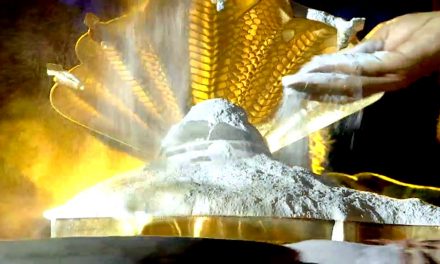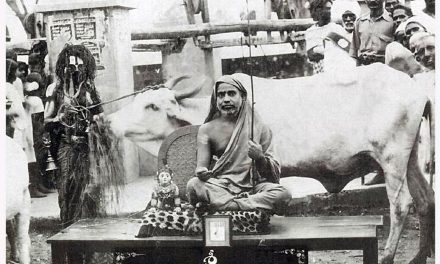The term Vedanga (“member of the Veda”) refers to six auxiliary disciplines for the understanding and tradition of the Vedas. These six disciplines are:
1. Shiksha (siksa): phonetics and phonology (sandhi)
2. Chandas (chandas): meter
3. Vyakarana (vyakarana): grammar
4. Nirukta (nirukta): etymology
5. Jyotisha (jyotisha): astrology and astronomy, dealing particularly with the auspicious days for performing sacrifices.
6. Kalpa (kalpa): Ritual
Traditionally, vyakarana and nirukta are shared across all four Vedas, while each Veda has its own shiksha, chandas, kalpa and jyotiisha. The Vedangas are first mentioned in the Mundaka Upanishad as topics to be observed by students of the Vedas. Later, they developed into independent disciplines, each with its own corpus of Sutras. As described in Wikipedia, kalpa is one of the six disciplines of Vedanga, treating ritual.
Tradition does not single out any special work in this branch of the Vedanga, but sacrificial practice gave rise to a large number of systematic sutras for the several classes of priests. A number of these works have come down to us, and they occupy by far the most prominent place among the literary productions of the sutra-period.
The Kalpa-sutras, or rules of ceremonial, are of two kinds:
(1) the Shrautasutras, which are based on the shruti, and teach the performance of the great sacrifices, requiring three or five sacrificial fires; and
(2) the Smartasutras, or rules based on the smrti or tradition.
The latter class again includes two kinds of treatises:
(1) the Grhyasutras, or domestic rules, treating the rites of passage, such as marriage, birth, name giving, etc., connected with simple offerings into the domestic fire; and
(2) the Dharmasutras, which treat customs and social duties, and have formed the chief sources of the later law-books.
Further, the Shrauta-sutras of the Yajurveda have usually include a set of so-called Shulva-sutras, i.e. rules of the cord, which treat of the measurement by means of cords, and the construction, of different kinds of altars required for sacrifices. These treatises are of special interest and supply important information regarding the earliest geometrical operations in India.
Along with the Sutras may be classed a large number of supplementary treatises, usually called Parishishta, on various subjects connected with the sacred texts and Vedic religion generally.
Shrauta Sutras
The Shrautasutras (srautasutra) form a part of the corpus of Sanskrit Sutra literature. Their topic are the instructions relating to the use of the shruti corpus in ritual (kalpa) and the correct performance of rituals as such. Some early Shrautasutras were composed in the late Brahmana period (such as the Baudhyanana and Vadhula Sutras), but the bulk of the Shrautasutras are roughly contemporary to the Grhya corpus of domestic Sutras, their language being late Vedic Sanskrit, dating to the middle of the first millennium BCE, generally predating Panini.
Veda, Srautasutra
Rgveda: Asvalayana Srautasutra, Sankhayana Srautasutra
Samaveda: Latyayana Srautasutra, Drahyayana Srautasutra, Jaiminiya Srautasutra
Krsna Yajurveda: Baudhayana Srautasutra, Vadhula Srautasutra, Manava Srautasutra, Bharadvaja Srautasutra, Apastamba Srautasutra, Hiranyakesi Srautasutra, Varaha Srautasutra, Vaikhanasa Srautasutra
Sukla Yajurveda: Katyayana Srautasutra
Atharvaveda: Vaitana Srautasutra
Grhya Sutras
The Grhya Sutras, or “domestic sutras”, are a category of Sanskrit texts prescribing Vedic ritual, mainly relating to rites of passage. Their language is late Vedic Sanskrit, and they date to around roughly 500 BCE, contemporary with the Shrautasutras. They are named after Vedic shakhas.
Veda, Grhyasutra
Rgveda: Asvalayana-Grhyasutra, Kausitaki-Grhyasutra, Sankhayana-Grhyasutra
Samaveda: Gobhila-Grhyasutra, Khadira-Grhyasutra (Drahyayana-Grhyasutra), Jaiminiya-Grhyasutra,Kauthuma-Grhyasutra
Krsna Yajurveda: Baudhayana-Grhyasutra, Hiranyakesi-Grhyasutra (Satyâsâdha-Grhyasutra), Manava-Grhyasutra, Bharadvaja-Grhyasutra, Apastamba-Grhyasutra, Âgnivesya-Grhyasutra,Vaikhanasa-Grhyasutra,Kathaka-Grhyasutra (Laugaksi-Grhyasutra), Varaha-Grhyasutra, Vadhula-Grhyasutra, Kapisthala-Katha Grhyasutra (unpublished)
Sukla Yajurveda: Katyayana Grhyasutra (different from Paraskara-Grhyasutra), Paraskara-Grhyasutra
Atharvaveda: Kausika Grhyasutra
Dharma Sutras
The Dharmasutras are Sanskrit texts dealing with custom, rituals and law. They include the four surviving written works of the ancient Indian tradition on the subject of dharma, or the rules of behavior recognized by a community. Unlike the later Dharmashastra, the dharmasutras are composed in prose. The oldest Dharmasutra is generally believed to have been that of Apastamba, followed by the dharmasutras of Gautama, Baudhayana, and an early version of Vasishtha. It is difficult to determine exact dates for these texts, but the dates between 500-300 BCE have been suggested for the oldest Dharmasutras. Later Dharmasutras include those of Kasyapa, Brhaspati, and Ushanas.
Veda, Dharmasutra
Rgveda: Vasishtha Dharmasutra
Samaveda: Gautama Dharmasutra
Krsna Yajurveda: Baudhayana Dharmasutra, Apastamba Dharmasutra
Shulba Sutras
The Sulbasutra that deal with laying out the offering ground and altar geometry are part of the Shrauta Sutras.
Veda, Sulbasutra
Krsna Yajurveda: Baudhayana Sulbasutra, Manava Sulbasutra, Apastamba Sulbasutra
Sukla Yajurveda: Katyayana Sulbasutra












